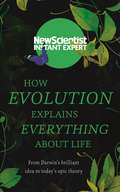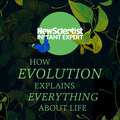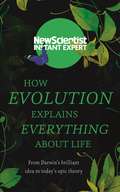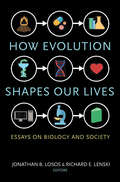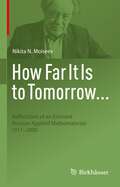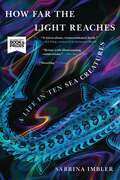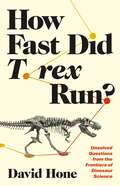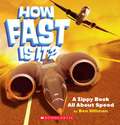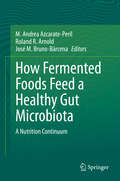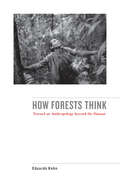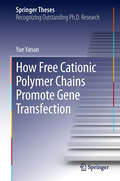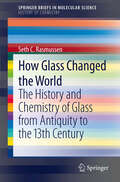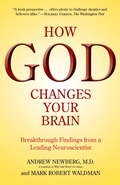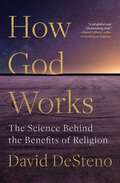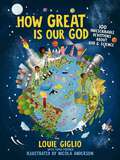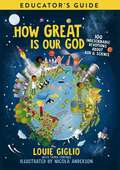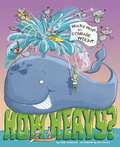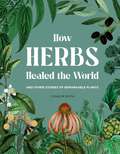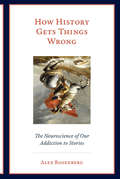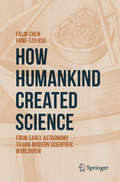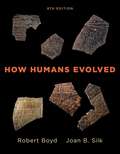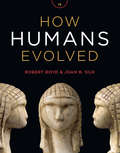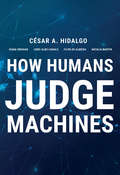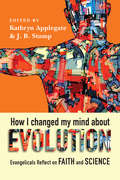- Table View
- List View
How Evolution Explains Everything About Life: From Darwin's brilliant idea to today's epic theory (New Scientist Instant Expert)
by New ScientistHow did we get here? All cultures have a creation story, but a little over 150 years ago Charles Darwin introduced a revolutionary new one. We, and all living things, exist because of the action of evolution on the first simple life form and its descendants.We now know that it has taken 3.8 billions of years of work by the forces of evolution to turn what was once a lump of barren rock into the rich diversity of into plants, animals and microbes that surround us. In the process, evolution has created all manner of useful adaptions, from biological computers (brains) to a system to capture energy from the sun (photosynthesis). But how does evolution actually work? In Evolution, leading biologists and New Scientist take you on a journey of a lifetime, exploring the question of whether life is inevitable or a one-off fluke, and how it got kick-started. Does evolution have a purpose or direction? Are selfish genes really the driving force of evolution? And is evolution itself evolving?ABOUT THE SERIESNew Scientist Instant Expert books are definitive and accessible entry points to the most important subjects in science; subjects that challenge, attract debate, invite controversy and engage the most enquiring minds. Designed for curious readers who want to know how things work and why, the Instant Expert series explores the topics that really matter and their impact on individuals, society, and the planet, translating the scientific complexities around us into language that's open to everyone, and putting new ideas and discoveries into perspective and context.
How Evolution Explains Everything About Life: From Darwin's brilliant idea to today's epic theory (New Scientist Instant Expert)
by New ScientistThe journey of a lifetime exploring the question of whether life is inevitable or a one-off fluke, and how it got kick-started.How did we get here? All cultures have a creation story, but a little over 150 years ago Charles Darwin introduced a revolutionary new one. We, and all living things, exist because of the action of evolution on the first simple life form and its descendants.We now know that it has taken 3.8 billions of years of work by the forces of evolution to turn what was once a lump of barren rock into the rich diversity of into plants, animals and microbes that surround us. In the process, evolution has created all manner of useful adaptions, from biological computers (brains) to a system to capture energy from the sun (photosynthesis). But how does evolution actually work? In Evolution, leading biologists and New Scientist take you on a journey of a lifetime, exploring the question of whether life is inevitable or a one-off fluke, and how it got kick-started. Does evolution have a purpose or direction? Are selfish genes really the driving force of evolution? And is evolution itself evolving?ABOUT THE SERIESNew Scientist Instant Expert books are definitive and accessible entry points to the most important subjects in science; subjects that challenge, attract debate, invite controversy and engage the most enquiring minds. Designed for curious readers who want to know how things work and why, the Instant Expert series explores the topics that really matter and their impact on individuals, society, and the planet, translating the scientific complexities around us into language that's open to everyone, and putting new ideas and discoveries into perspective and context.(P) 2017 Hodder & Stoughton Limited
How Evolution Explains Everything About Life: From Darwins brilliant idea to todays epic theory (Instant Expert)
by New ScientistHow did we get here? All cultures have a creation story, but a little over 150 years ago Charles Darwin introduced a revolutionary new one. We, and all living things, exist because of the action of evolution on the first simple life form and its descendants. We now know that it has taken 3.8 billions of years of work by the forces of evolution to turn what was once a lump of barren rock into the rich diversity of into plants, animals and microbes that surround us. In the process, evolution has created all manner of useful adaptions, from biological computers (brains) to a system to capture energy from the sun (photosynthesis). But how does evolution actually work? In How Evolution Explains Everything, leading biologists and New Scientist take you on a journey of a lifetime, exploring the question of whether life is inevitable or a one-off fluke, and how it got kick-started. Does evolution have a purpose or direction? Are selfish genes really the driving force of evolution? And is evolution itself evolving?
How Evolution Shapes Our Lives: Essays on Biology and Society
by Richard E. Lenski Jonathan B. LososIt is easy to think of evolution as something that happened long ago, or that occurs only in "nature," or that is so slow that its ongoing impact is virtually nonexistent when viewed from the perspective of a single human lifetime. But we now know that when natural selection is strong, evolutionary change can be very rapid. In this book, some of the world's leading scientists explore the implications of this reality for human life and society. With some twenty-three essays, this volume provides authoritative yet accessible explorations of why understanding evolution is crucial to human life--from dealing with climate change and ensuring our food supply, health, and economic survival to developing a richer and more accurate comprehension of society, culture, and even what it means to be human itself. Combining new essays with essays revised and updated from the acclaimed Princeton Guide to Evolution, this collection addresses the role of evolution in aging, cognition, cooperation, religion, the media, engineering, computer science, and many other areas. The result is a compelling and important book about how evolution matters to humans today.The contributors are Dan I. Andersson, Francisco J. Ayala, Amy Cavanaugh, Cameron R. Currie, Dieter Ebert, Andrew D. Ellington, Elizabeth Hannon, John Hawks, Paul Keim, Richard E. Lenski, Tim Lewens, Jonathan B. Losos, Virpi Lummaa, Jacob A. Moorad, Craig Moritz, Martha M. Muñoz, Mark Pagel, Talima Pearson, Robert T. Pennock, Daniel E. L. Promislow, Erik M. Quandt, David C. Queller, Robert C. Richardson, Eugenie C. Scott, H. Bradley Shaffer, Joan E. Strassmann, Alan R. Templeton, Paul E. Turner, and Carl Zimmer.
How Far It Is to Tomorrow...: Reflections of an Eminent Russian Applied Mathematician 1917-2000
by Nikita N. MoiseevThis is a translated autobiography of applied mathematician N. N. Moiseev, providing an insider’s view of the history of the Soviet Union from its founding in 1917 to its collapse in 1991, as well as a little of the aftermath.We see vividly the precariousness of life just after the October Revolution; his happy family life during the years 1921-28 of Lenin’s New Economic Policy; the subsequent destruction of his family by Stalin’s regime; his trials as a social outcast; his student days at Moscow State University; his experiences as a Soviet Air Force Engineer in World War II, including sorties as a gunner and a brush with an NKVD agent; post-war euphoria, marriage, and another round of ostracism; and then the vicissitudes of a highly varied academic career. Here we meet many famous Soviet and Western engineers and scientists. The last several chapters are devoted more to wide-ranging reflections on God, philosophy, science, communism, modelling the biosphere, and the threat of nuclear winter. His thoughts concerning the impending and then final collapse of the USSR, as well as hopes for Russia’s future, conclude the journey through Moiseev's life.
How Far the Light Reaches: A Life in Ten Sea Creatures
by Sabrina ImblerA fascinating tour of creatures from the surface to the deepest ocean floor: this "miraculous, transcendental book" invites us to envision wilder, grander, and more abundant possibilities for the way we live (Ed Yong, author of An Immense World). A queer, mixed race writer working in a largely white, male field, science and conservation journalist Sabrina Imbler has always been drawn to the mystery of life in the sea, and particularly to creatures living in hostile or remote environments. Each essay in their debut collection profiles one such creature, including: ·the mother octopus who starves herself while watching over her eggs, ·the Chinese sturgeon whose migration route has been decimated by pollution and dams, ·the bizarre, predatory Bobbitt worm (named after Lorena), ·the common goldfish that flourishes in the wild, ·and more. Imbler discovers that some of the most radical models of family, community, and care can be found in the sea, from gelatinous chains that are both individual organisms and colonies of clones to deep-sea crabs that have no need for the sun, nourished instead by the chemicals and heat throbbing from the core of the Earth. Exploring themes of adaptation, survival, sexuality, and care, and weaving the wonders of marine biology with stories of their own family, relationships, and coming of age, How Far the Light Reaches is a shimmering, otherworldly debut that attunes us to new visions of our world and its miracles. WINNER OF THE LOS ANGELES TIMES BOOK PRIZE in SCIENCE & TECHNOLOGY Finalist for the Lambda Literary Award One of TIME&’s 10 Best Nonfiction Books of the Year • A PEOPLE Best New Book • A Barnes & Noble and SHELF AWARENESS Best Book of 2022 • An Indie Next Pick • One of Winter&’s Most Eagerly Anticipated Books: VANITY FAIR, VULTURE, BOOKRIOT
How Fast Did T. rex Run?: Unsolved Questions from the Frontiers of Dinosaur Science
by David HoneThe revolution in science that is transforming our understanding of dinosaursIn just the past twenty years, we have learned more about dinosaurs than we did in the previous two centuries. This book describes the extraordinary advances in palaeontology that are beginning to solve many of the mysteries surrounding these marvelous prehistoric creatures, from their ways of communicating to their mating habits, the color of their skin, their migration patterns and extinction. How did dinosaurs rear their young? What did they eat? What did T. rex actually do with those tiny arms? David Hone draws on his own discoveries at the forefront of dinosaur science to illuminate these and other questions.Each chapter in this lively and informative book covers a key topic in dinosaur science, such as origins, diversity, evolution, habitats, anatomy, behaviour, ecology and dinosaur descendants—the birds. For each topic, Hone discusses the history of what palaeontologists thought in the past, the new insights we are gleaning from recent fossil finds and the latest technologies and the gaps in our knowledge that still remain. He shares his own predictions about the research areas that may produce the next big ideas in dinosaur science and addresses the unknowns we may never solve.How Fast Did T. rex Run? reveals everything we now know about dinosaurs—and everything we don’t—and charts thrilling new directions for tomorrow’s generation of dinosaur scientists.
How Fast Is It?: A Zippy Book All About Speed
by Ben HillmanIn this third book by Ben Hillman, young readers will learn and see just how fast something is. By comparing objects such as the Thrust SSC (that's a Thrust-powered Super Sonic Car), an ostrich (don't underestimate the ostrich, my friend!), the human brain, and bamboo,wildly different objects are taken out of normal context and placed next to one another to allow for new and exciting perspectives. So just how fast is an ostrich? An ostrich would beat a top-notch professional cyclist in a ten-mile (sixteen km) race, hands down! While the best cyclists can race at blistering speeds of twenty-five miles per hour, the ostrich can run at forty-five miles per hour! Other books in the series that kids will enjoy: How Big Is It? and How Strong Is It?
How Fermented Foods Feed a Healthy Gut Microbiota: A Nutrition Continuum
by M. Andrea Azcarate-Peril Roland R. Arnold José M. Bruno-BárcenaThis book examines the role of fermented foods on human gut health and offers a unique contribution to this rapidly growing area of study. Fermented foods have been consumed by humans for millennia. This method of food preservation provided early humans with beneficial bacteria that re-populated the gut microbiota upon consumption. However, novel methods of production and conservation of food have led to severed ties between the food that modern humans consume and the gut microbiota. As a consequence, there has been a documented increase in the prevalence of autoimmune diseases and obesity, which has been correlated to decreased diversity of gut microbes, while infectious disorders have decreased in the three past decades.With the intention of providing a thorough overview of the relationship between fermented foods, nutrition, and health, the editors have grouped the chapters into three thematic sections: food and their associated microbes, the oral microbiome, and the gut microbiome. After an introduction dedicated to the environmental microbiome, Part I provides an overview of what is currently known about the microbes associated with different foods, and compares traditional forms of food preparation with current industrial techniques in terms of the potential loss of microbial diversity. The chapters in Part 2 explore the oral microbiota as a microbial gatekeeper and main contributor to the gut microbiota. Part 3 introduces beneficial modulators of the gut microbiome starting with the establishment of a healthy gut microbiota during infancy, and continuing with the role of probiotics and prebiotics in health preservation and the imbalances of the gut microbiota. In the final section the editors offer concluding remarks and provide a view of the future brought by the microbiome research revolution.This study is unique in its emphasis on the convergence of two very relevant fields of research: the field of studies on Lactic Acid Bacteria (LAB) and fermented foods, and microbiome research. The relationship between these fields, as presented by the research in this volume, demonstrates the intimate connection between fermented foods, the oral and gut microbiota, and human health. Although research has been done on the impact of diet on the gut microbiome there are no publications addressing the restorative role of food as microbe provider to the gut microbiota. This novel approach makes the edited volume a key resource for scientific researchers working in this field.
How Forests Think: Toward an Anthropology Beyond the Human
by Eduardo KohnCan forests think? Do dogs dream? In this astonishing book, Eduardo Kohn challenges the very foundations of anthropology, calling into question our central assumptions about what it means to be human—and thus distinct from all other life forms. Based on four years of fieldwork among the Runa of Ecuador’s Upper Amazon, Eduardo Kohn draws on his rich ethnography to explore how Amazonians interact with the many creatures that inhabit one of the world’s most complex ecosystems. Whether or not we recognize it, our anthropological tools hinge on those capacities that make us distinctly human. However, when we turn our ethnographic attention to how we relate to other kinds of beings, these tools (which have the effect of divorcing us from the rest of the world) break down. How Forests Think seizes on this breakdown as an opportunity. Avoiding reductionistic solutions, and without losing sight of how our lives and those of others are caught up in the moral webs we humans spin, this book skillfully fashions new kinds of conceptual tools from the strange and unexpected properties of the living world itself. In this groundbreaking work, Kohn takes anthropology in a new and exciting direction–one that offers a more capacious way to think about the world we share with other kinds of beings.
How Free Cationic Polymer Chains Promote Gene Transfection
by Yue YananIn this PhD thesis, Yue Yanan addresses a long-overlooked and critical question in the development of non-viral vectors for gene delivery. The author determines that those uncomplexed and cationic polymer chains free in the solution mixture of polymer and DNA facilitate and promote gene transfection. Furthermore, by using a combination of synthetic chemistry, polymer physics and molecular biology, Yue confirms that it is those cationic polymer chains free in the solution mixture, rather than those bound to DNA chains, that play a decisive role in intracellular trafficking. Instead of the previously proposed and widely accepted "proton sponge" model, the author's group propose a new hypothesis based on the results of several well-designed and decisive experiments. These results show that free polycationic chains with a length of more than ~10 nm are able to partially block the fusion between different endocytic vesicles, including the endocytic-vesicle-to-endolysosome pathway. This thesis is highly original and its results greatly deepen our understanding of polymer-mediated gene transfection. More importantly, it provides new insights into the rational design of next-generation superior polymeric gene-delivery vectors.
How Glass Changed the World
by Seth C. RasmussenGlass production is thought to date to ~2500 BC and had found numerous uses by the height of the Roman Empire. Yet the modern view of glass-based chemical apparatus (beakers, flasks, stills, etc.) was quite limited due to a lack of glass durability under rapid temperature changes and chemical attack. This "brief" gives an overview of the history and chemistry of glass technology from its origins in antiquity to its dramatic expansion in the 13th century, concluding with its impact on society in general, particularly its effect on chemical practices.
How God Changes Your Brain: Breakthrough Findings from a Leading Neuroscientist
by Andrew Newberg Mark Robert Waldman"How God Changes Your Brain" is a highly practical, easy-to-read guide on the interface between spirituality and neuroscience, filled with useful information that can make your brain and your life better. --Daniel G. Amen, M. D.
How God Works: The Science Behind the Benefits of Religion
by David DeStenoDrawing on a wealth of new evidence, pioneering research psychologist David DeSteno shows why religious practices and rituals are so beneficial to those who follow them—and to anyone, regardless of their faith (or lack thereof).Scientists are beginning to discover what believers have known for a long time: the rewards that a religious life can provide. For millennia, people have turned to priests, rabbis, imams, shamans, and others to help them deal with issues of grief and loss, birth and death, morality and meaning. In this absorbing work, DeSteno reveals how numerous religious practices from around the world improve emotional and physical well-being. With empathy and rigor, DeSteno chronicles religious rites and traditions from cradle to grave. He explains how the Japanese rituals surrounding childbirth help strengthen parental bonds with children. He describes how the Apache Sunrise Ceremony makes teenage girls better able to face the rigors of womanhood. He shows how Buddhist meditation reduces hostility and increases compassion. He demonstrates how the Jewish practice of sitting shiva comforts the bereaved. And much more. DeSteno details how belief itself enhances physical and mental health. But you don&’t need to be religious to benefit from the trove of wisdom that religion has to offer. Many items in religion&’s &“toolbox&” can help the body and mind whether or not one believes. How God Works offers advice on how to incorporate many of these practices to help all of us live more meaningful, successful, and satisfying lives.
How Great Is Our God: 100 Indescribable Devotions About God and Science (Indescribable Kids)
by Louie GiglioShow the children in your life the awe-inspiring connection between the natural world and the God who created it. The bestselling children's devotional Indescribable: 100 Devotions About God and Science resonated with more than 200,000 kids, parents, and teachers. Now Louie Giglio offers 100 more devotions about God and science that will expand the curiosity of your 6- to 10-year-olds. Including amazing scientific facts, beautiful photography, fun illustrations, and simple activities, How Great Is Our God covers topics likeSpace and timeEarth and weatherThe human bodyAnimalsPlantsAnd more!With this science devotional, which is based on Giglio's well-known "How Great Is Our God" and “Indescribable” messages, children will embark on a journey to discover more about God and His incredible creation. From the pink lake in Senegal to the earth's trip around the sun to the water-holding frog that can live up to five years without a drink, the wonders of the universe will deepen your kids’ appreciation for God's wild imagination.
How Great Is Our God Educator's Guide: 100 Indescribable Devotions About God and Science
by Louie GiglioHow Great Is Our God Educator's Guide is a companion to How Great Is Our God: 100 Indescribable Devotions About God and Science by Louie Giglio. This guide can be utilized in the classroom, in a home school setting, or by parents seeking additional resources. Ideal for grades 3rd-5th.
How Heavy?: Wacky Ways To Compare Weight (Wacky Comparisons)
by Mark Weakland Advocate-Art Staff Bill Bolton Terry FlahertyCompares various heavy objects to lighter objects in unique, illustrated ways.
How Herbs Healed the World: And Other Stories of Remarkable Plants
by Connor Smith'The writing shines when recounting the stories behind these herbs, offering a blend of history and botanical fascination' - RHS, The GardenHerbs are wonderful things. Without them so much would not be possible. With the advance of science over the last two hundred years these once mystical plants have changed and saved countless lives, vastly improving our standard of living while providing us all with a much richer, healthier diet. Today, we take for granted a world full oflife-saving drugs, luxury cosmetics and exotic foods.This fascinating book will tell this story: revealing how poisons once used by the ancient Romans such as Deadly Nightshade are now being used in modern medicine or how the herbs used by indigenous people around the world have provided remedies for countless illnesses. It will explore the myths and legends behind herbs such as the infamous Mandrake and how herbs such as Yarrow are still being used to treat wounds today, just as they were thousands of years ago; and it will show how exotic herbs from across the globe have enriched our livesand delve into the origins of the culinary herbs that everyone knows and loves.Seventy-five herbs have been carefully chosen to tell the story of how they have each changed our world, looking back at their origins and what was once believed, while comparing this with the modern day uses and the scientific value of these plants enabling the reader to understand and appreciate their importance.Each double page spread will provide both historic and modern illustrations of each herb alongside captivating accounts of their historical and modern day uses including supplementary botanical and horticultural information for each.
How Herbs Healed the World: And Other Stories of Remarkable Plants
by Connor Smith'The writing shines when recounting the stories behind these herbs, offering a blend of history and botanical fascination' - RHS, The GardenHerbs are wonderful things. Without them so much would not be possible. With the advance of science over the last two hundred years these once mystical plants have changed and saved countless lives, vastly improving our standard of living while providing us all with a much richer, healthier diet. Today, we take for granted a world full oflife-saving drugs, luxury cosmetics and exotic foods.This fascinating book will tell this story: revealing how poisons once used by the ancient Romans such as Deadly Nightshade are now being used in modern medicine or how the herbs used by indigenous people around the world have provided remedies for countless illnesses. It will explore the myths and legends behind herbs such as the infamous Mandrake and how herbs such as Yarrow are still being used to treat wounds today, just as they were thousands of years ago; and it will show how exotic herbs from across the globe have enriched our livesand delve into the origins of the culinary herbs that everyone knows and loves.Seventy-five herbs have been carefully chosen to tell the story of how they have each changed our world, looking back at their origins and what was once believed, while comparing this with the modern day uses and the scientific value of these plants enabling the reader to understand and appreciate their importance.Each double page spread will provide both historic and modern illustrations of each herb alongside captivating accounts of their historical and modern day uses including supplementary botanical and horticultural information for each.
How History Gets Things Wrong: The Neuroscience of Our Addiction to Stories (The\mit Press Ser.)
by Alex RosenbergWhy we learn the wrong things from narrative history, and how our love for stories is hard-wired.To understand something, you need to know its history. Right? Wrong, says Alex Rosenberg in How History Gets Things Wrong. Feeling especially well-informed after reading a book of popular history on the best-seller list? Don't. Narrative history is always, always wrong. It's not just incomplete or inaccurate but deeply wrong, as wrong as Ptolemaic astronomy. We no longer believe that the earth is the center of the universe. Why do we still believe in historical narrative? Our attachment to history as a vehicle for understanding has a long Darwinian pedigree and a genetic basis. Our love of stories is hard-wired. Neuroscience reveals that human evolution shaped a tool useful for survival into a defective theory of human nature. Stories historians tell, Rosenberg continues, are not only wrong but harmful. Israel and Palestine, for example, have dueling narratives of dispossession that prevent one side from compromising with the other. Henry Kissinger applied lessons drawn from the Congress of Vienna to American foreign policy with disastrous results. Human evolution improved primate mind reading—the ability to anticipate the behavior of others, whether predators, prey, or cooperators—to get us to the top of the African food chain. Now, however, this hard-wired capacity makes us think we can understand history—what the Kaiser was thinking in 1914, why Hitler declared war on the United States—by uncovering the narratives of what happened and why. In fact, Rosenberg argues, we will only understand history if we don't make it into a story.
How Humankind Created Science: From Early Astronomy to Our Modern Scientific Worldview
by Falin Chen Fang-Tzu HsuThe development of science has been an ideological struggle that lasted over three millennia. At and after the times of the Babylonian Empire, however, the pace of scientific evolution was painfully slow. This situation changed after Copernicus kick-started the Scientific Revolution with his heliocentric theory. Newton’s law of universal gravitation transformed natural philosophy, previously focused on mythology and abstract philosophical thinking, into an orderly and rational physical science. Einstein’s redefinition of space and time revealed a new and central principle of the Universe, paving the way for the huge amounts of energy held deep inside physical matter to be released. To this day, many of the our known physical theories represent an accumulation of changing knowledge over the long course of scientific history. But what kind of changes did the scientists see? What questions did they address? What methods did they use? What difficulties did they encounter? And what kind of persecution might they have faced on the road to discovering these beautiful, sometimes almost mystical, ideas? This book’s purpose is to investigate these questions. It leads the reader through the stories behind major scientific advancements and their theories, as well as explaining associated examples and hypotheses. Over the course of the journey, readers will come to understand the way scientists explore nature and how scientific theories are applied to natural phenomena and every-day technology.
How Humans Evolved
by Robert Boyd Joan B. SilkThis book focuses on the processes that have shaped human evolution. As anthropologists, the authors are interested in the evolutionary history of their own species. Homo sapiens and the diversity of contemporary human societies. As evolutionary biologists, the authors study how evolution works to shape the natural world. In this book, they integrate these two perspectives and use current theoretical and empirical work in evolutionary theory, population genetics and behavioral ecology to interpret human evolutionary history. They describe the changes that have occurred as the human lineage has evolved and consider why these changes may have happened. By focusing on the processes that generate change, create adaptations and shape bodies and behavior, they try to give life to the creatures that left the bones and made the artifacts that paleontologists and archaeologists painstakingly excavate. The authors also pay serious attention to the role of evolution in shaping contemporary human behavior. The list of references for further reading at the end of each chapter provides a starting point for students who want to delve more deeply into the material covered in that chapter.
How Humans Evolved (Seventh Edition)
by Robert Boyd Joan B. SilkGive students a complete picture of human evolution.
How Humans Judge Machines
by Cesar A. Hidalgo Diana Orghiain Jordi Albo Canals Filipa De Almeida Natalia MartinHow people judge humans and machines differently, in scenarios involving natural disasters, labor displacement, policing, privacy, algorithmic bias, and more.How would you feel about losing your job to a machine? How about a tsunami alert system that fails? Would you react differently to acts of discrimination depending on whether they were carried out by a machine or by a human? What about public surveillance? How Humans Judge Machines compares people's reactions to actions performed by humans and machines. Using data collected in dozens of experiments, this book reveals the biases that permeate human-machine interactions. Are there conditions in which we judge machines unfairly? Is our judgment of machines affected by the moral dimensions of a scenario? Is our judgment of machine correlated with demographic factors such as education or gender? César Hidalgo and colleagues use hard science to take on these pressing technological questions. Using randomized experiments, they create revealing counterfactuals and build statistical models to explain how people judge artificial intelligence and whether they do it fairly. Through original research, How Humans Judge Machines bring us one step closer tounderstanding the ethical consequences of AI.
How I Changed My Mind About Evolution: Evangelicals Reflect on Faith and Science (BioLogos Books on Science and Christianity)
by J. B. Stump Deborah Haarsma Kathryn ApplegateFrancis CollinsDeborah HaarsmaDenis LamoureuxJohn OrtbergKen FongLaura TruaxN. T. WrightScot McKnightTremper Longman IIIJames K. A. SmithAmos YongOliver Crisp
